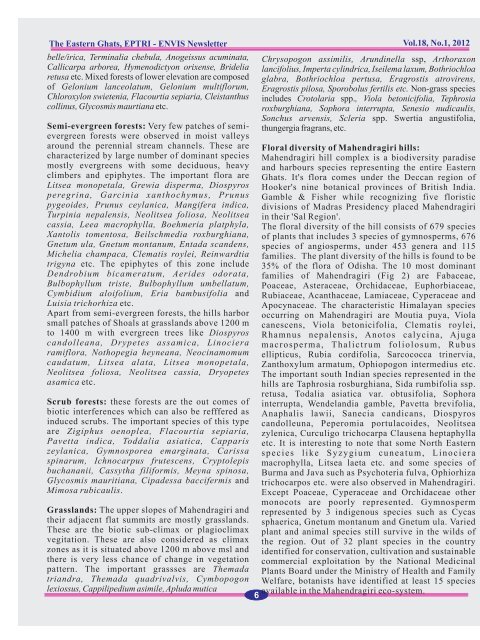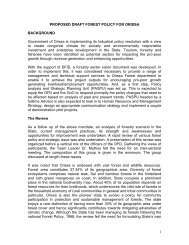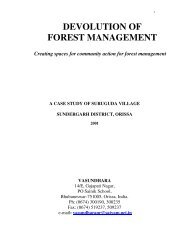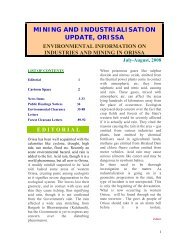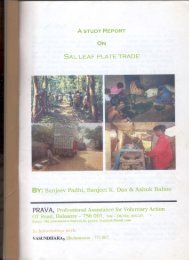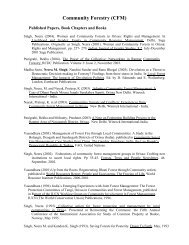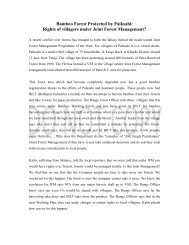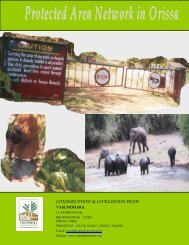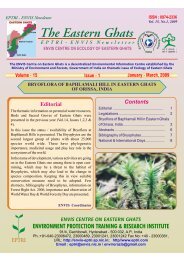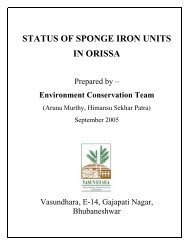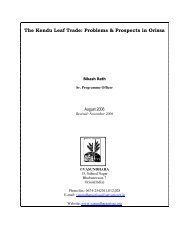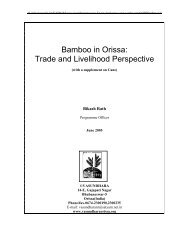Bio-Diversity and Cultural Aspects of Mahendragiri, in ... - Vasundhara
Bio-Diversity and Cultural Aspects of Mahendragiri, in ... - Vasundhara
Bio-Diversity and Cultural Aspects of Mahendragiri, in ... - Vasundhara
- No tags were found...
Create successful ePaper yourself
Turn your PDF publications into a flip-book with our unique Google optimized e-Paper software.
The Eastern Ghats, EPTRI - ENVIS Newsletter Vol.18, No.1, 2012belle/irica, Term<strong>in</strong>alia chebula, Anogeissus acum<strong>in</strong>ata,Callicarpa arborea, Hymenodictyon orixense, Brideliaretusa etc. Mixed forests <strong>of</strong> lower elevation are composed<strong>of</strong> Gelonium lanceolatum, Gelonium multiflorum,Chloroxylon swietenia, Flacourtia sepiaria, Cleistanthuscoll<strong>in</strong>us, Glycosmis maurtiana etc.Semi-evergreen forests: Very few patches <strong>of</strong> semievergreenforests were observed <strong>in</strong> moist valleysaround the perennial stream channels. These arecharacterized by large number <strong>of</strong> dom<strong>in</strong>ant speciesmostly evergreens with some deciduous, heavyclimbers <strong>and</strong> epiphytes. The important flora areLitsea monopetala, Grewia disperma, Diospyrosperegr<strong>in</strong>a, Garc<strong>in</strong>ia xanthochymus, Prunuspygeoides, Prunus ceylanica, Mangifera <strong>in</strong>dica,Turp<strong>in</strong>ia nepalensis, Neolitsea foliosa, Neolitseacassia, Leea macrophylla, Boehmeria platphyla,Xantolis tomentosa, Beilschmedia roxburghiana,Gnetum ula, Gnetum montanum, Entada sc<strong>and</strong>ens,Michelia champaca, Clematis roylei, Re<strong>in</strong>wardtiatrigyna etc. The epiphytes <strong>of</strong> this zone <strong>in</strong>cludeDendrobium bicameratum, Aerides odorata,Bulbophyllum triste, Bulbophyllum umbellatum,Cymbidium aloifolium, Eria bambusifolia <strong>and</strong>Luisia trichorhiza etc.Apart from semi-evergreen forests, the hills harborsmall patches <strong>of</strong> Shoals at grassl<strong>and</strong>s above 1200 mto 1400 m with evergreen trees like Diospyrosc<strong>and</strong>olleana, Drypetes assamica, L<strong>in</strong>ocieraramiflora, Nothopegia heyneana, Neoc<strong>in</strong>amomumcaudatum, Litsea alata, Litsea monopetala,Neolitsea foliosa, Neolitsea cassia, Dryopetesasamica etc.Scrub forests: these forests are the out comes <strong>of</strong>biotic <strong>in</strong>terferences which can also be refffered as<strong>in</strong>duced scrubs. The important species <strong>of</strong> this typeare Zigiphus oenoplea, Flacourtia sepiaria,Pavetta <strong>in</strong>dica, Toddalia asiatica, Cappariszeylanica, Gymnosporea emarg<strong>in</strong>ata, Carissasp<strong>in</strong>arum, Ichnocarpus frutescens, Cryptolepisbuchananii, Cassytha filiformis, Meyna sp<strong>in</strong>osa,Glycosmis mauritiana, Cipadessa baccifermis <strong>and</strong>Mimosa rubicaulis.Grassl<strong>and</strong>s: The upper slopes <strong>of</strong> <strong>Mahendragiri</strong> <strong>and</strong>their adjacent flat summits are mostly grassl<strong>and</strong>s.These are the biotic sub-climax or plagioclimaxvegitation. These are also considered as climaxzones as it is situated above 1200 m above msl <strong>and</strong>there is very less chance <strong>of</strong> change <strong>in</strong> vegetationpattern. The important grassses are Themadatri<strong>and</strong>ra, Themada quadrivalvis, Cymbopogonlexiossus, Cappilipedium asimile, Apluda muticaChrysopogon assimilis, Arund<strong>in</strong>ella ssp, Arthoraxonlancifolius, Imperta cyl<strong>in</strong>drica, Iseilema laxum, Bothriochloaglabra, Bothriochloa pertusa, Eragrostis atrovirens,Eragrostis pilosa, Sporobolus fertilis etc. Non-grass species<strong>in</strong>cludes Crotolaria spp., Viola betonicifolia, Tephrosiaroxburghiana, Sophora <strong>in</strong>terrupta, Senesio nudicaulis,Sonchus arvensis, Scleria spp. Swertia angustifolia,thungergia fragrans, etc.Floral diversity <strong>of</strong> <strong>Mahendragiri</strong> hills:<strong>Mahendragiri</strong> hill complex is a biodiversity paradise<strong>and</strong> harbours species represent<strong>in</strong>g the entire EasternGhats. It's flora comes under the Deccan region <strong>of</strong>Hooker's n<strong>in</strong>e botanical prov<strong>in</strong>ces <strong>of</strong> British India.Gamble & Fisher while recogniz<strong>in</strong>g five floristicdivisions <strong>of</strong> Madras Presidency placed <strong>Mahendragiri</strong><strong>in</strong> their 'Sal Region'.The floral diversity <strong>of</strong> the hill consists <strong>of</strong> 679 species<strong>of</strong> plants that <strong>in</strong>cludes 3 species <strong>of</strong> gymnosperms, 676species <strong>of</strong> angiosperms, under 453 genera <strong>and</strong> 115families. The plant diversity <strong>of</strong> the hills is found to be35% <strong>of</strong> the flora <strong>of</strong> Odisha. The 10 most dom<strong>in</strong>antfamilies <strong>of</strong> <strong>Mahendragiri</strong> (Fig 2) are Fabaceae,Poaceae, Asteraceae, Orchidaceae, Euphorbiaceae,Rubiaceae, Acanthaceae, Lamiaceae, Cyperaceae <strong>and</strong>Apocynaceae. The characteristic Himalayan speciesoccurr<strong>in</strong>g on <strong>Mahendragiri</strong> are Moutia puya, Violacanescens, Viola betonicifolia, Clematis roylei,Rhamnus nepalensis, Anotos calyc<strong>in</strong>a, Ajugamacrosperma, Thalictrum foliolosum, Rubusellipticus, Rubia cordifolia, Sarcococca tr<strong>in</strong>ervia,Zanthoxylum armatum, Ophiopogon <strong>in</strong>termedius etc.The important south Indian species represented <strong>in</strong> thehills are Taphrosia rosburghiana, Sida rumbifolia ssp.retusa, Todalia asiatica var. obtusifolia, Sophora<strong>in</strong>terrupta, Wendel<strong>and</strong>ia gamble, Pavetta brevifolia,Anaphalis lawii, Sanecia c<strong>and</strong>icans, Diospyrosc<strong>and</strong>olleuna, Peperomia portulacoides, Neolitseazylenica, Curculigo trichocarpa Clausena heptaphyllaetc. It is <strong>in</strong>terest<strong>in</strong>g to note that some North Easternspecies like Syzygium cuneatum, L<strong>in</strong>ocieramacrophylla, Litsea laeta etc. <strong>and</strong> some species <strong>of</strong>Burma <strong>and</strong> Java such as Psychoteria fulva, Ophiorhizatrichocarpos etc. were also observed <strong>in</strong> <strong>Mahendragiri</strong>.Except Poaceae, Cyperaceae <strong>and</strong> Orchidaceae othermonocots are poorly represented. Gymnospermrepresented by 3 <strong>in</strong>digenous species such as Cycassphaerica, Gnetum montanum <strong>and</strong> Gnetum ula. Variedplant <strong>and</strong> animal species still survive <strong>in</strong> the wilds <strong>of</strong>the region. Out <strong>of</strong> 32 plant species <strong>in</strong> the countryidentified for conservation, cultivation <strong>and</strong> susta<strong>in</strong>ablecommercial exploitation by the National Medic<strong>in</strong>alPlants Board under the M<strong>in</strong>istry <strong>of</strong> Health <strong>and</strong> FamilyWelfare, botanists have identified at least 15 speciesavailable <strong>in</strong> the <strong>Mahendragiri</strong> eco-system.6


